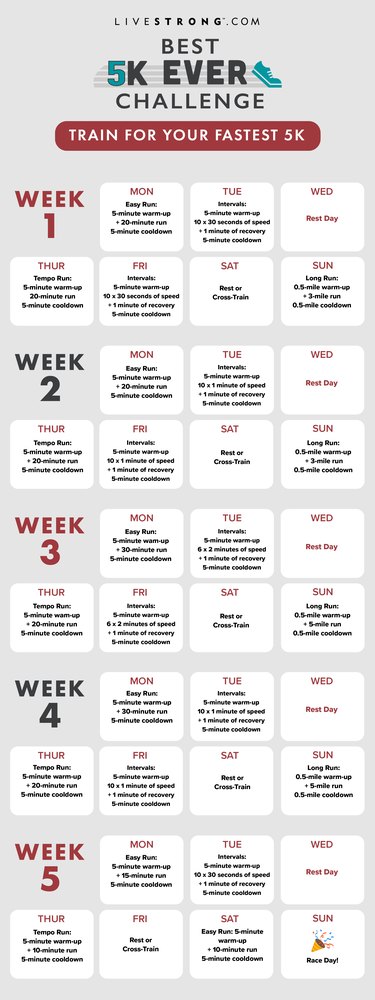
The 5K is the shortest standard running event and doesn't require a ton of time to prepare — but that doesn't mean it's easy, especially if you're looking to set a new personal record (PR).
The perfect training plan for a faster 5K requires a balance of intervals to build speed, long runs for endurance and proper rest to give your body a chance to recover.
If you have a solid three to six months of consistent running under your belt, as well as one 5K race to serve as your benchmark, you're ready to run your fastest 5K — either on your own or as part of our Best 5K Ever Challenge.
You'll find everything you need to ramp up your speed and build endurance in the training program below, created by Lize Brittin, an elite runner and author of Training on Empty, and Brad Hudson, running coach and founder of Hudson Elite.
New to the Best 5K Ever Challenge?
Get all the details on our five-week running program here!
Follow This 5-Week Plan for a Faster 5K
Your goal: Improve your race pace and set a PR for your 5K finish time.
You're ready if: You've been running four to seven days a week for about 20 to 40 minutes at a time over a span of three to six months and completed at least one 5K already.

Tip
Print out your training calendar here or save it on your phone so you'll see it every day and stay on track.
You'll run five days each week for the next five weeks: one easy run, two interval runs, a tempo run and a long run. Each week you'll have one rest day and one day of cross-training.
Each run begins with a five-minute warm-up (like a brisk walk or easy jog) and ends with a five-minute cooldown with walking and stretching. You might be tempted to skip these, but warming up and cooling down help you transition into and out of exercise safely.
What These Workouts Look Like
Easy Run
These runs are about logging miles at a conversational pace — about a 5 on a scale of 1 to 10. Your easy runs help you develop the endurance to cover five or six miles without undue effort and adequately recover between workouts.
Intervals
Interval training involves short bursts of speed followed by rest or recovery periods. For each workout, after your warm-up, you'll run (or sprint) as fast as you comfortably can for the specified time. Then, you'll either run slower or walk to recover.
Your speed bursts should be fast enough to challenge you for the duration but not so much that you have to stop completely. Similarly, your recovery should be fast enough to keep your heart rate up but not so fast that you can't speed up.
During Week 4, Hudson suggests runners give a lot of attention to the shorter, faster intervals and shorter, more active rests. "It develops running economy," he says. "That's important because it's basically the ability to run faster while expending the same amount of energy."
These sessions should be hard, but not completely exhausting. If you're truly struggling before the halfway point of these workouts, consider adjusting your pace.
Tempo Run
Run these 20-minute workouts at a pace you could hold for about an hour in a race. A tempo run should leave you just on the edge of not being able to hold a normal conversation but not gasping for air; this improves your endurance, according to the American Council on Exercise, and promotes confidence at medium-hard paces.
Hudson suggests runners focus on the feel of tempo runs and gradually increasing the pace from start to finish. "Our athletes focus on rhythm and familiarity with target pace for mental reasons, as well as to achieve a workout," he says. "They're able to hit tempo pace without any specific heart-rate or pace feedback once they're used to doing them."
Long Run
Long runs build endurance, the base of all distance running. These are measured in miles rather than minutes on your training calendar to help you get a better sense of what your 5K race will feel like. You want this pace to be harder than an easy run, but don't go as fast as you can or you'll risk burning out.
If you don't live near a walking path that has miles marked, measure the distance in your car, head to a local track (four laps equals one mile), use U.S. Track and Field's mapping tool, download an app like MapMyRun or consider investing in a fitness tracker.
Your long runs should closely mimic race conditions, so if you plan to run your 5K outside, try to do these training sessions outdoors, too — but you can also run on a treadmill.
Rest or Cross-Training
Rest days are full days off from exercise. If you're feeling fresh enough for some cross-training activity, do a workout other than running, such as yoga, swimming, biking, dancing or anything else that you enjoy. Just keep this added exercise easy on the days before your long runs so that you don't start these key workouts fatigued.
Tip
Don't do anything new or unusual on race morning. If you rarely drink coffee, for example, race day is not the time to load up on caffeine. Warm up slowly for 15 to 20 minutes, then get your body ready to go with three to four 20-second stride-outs, where you gradually increase your speed and lengthen your stride until you reach what feels like race pace.